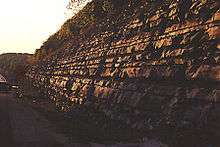Borden Formation
The Mississippian Borden Formation is a mapped bedrock unit in Kentucky, Indiana, Illinois, Ohio, West Virginia,[7] and Tennessee. It has many members, which has led some geologists to consider it a group (for example in Indiana[8]) rather than a formation (for example in Kentucky[1][4]).
| Borden Formation Stratigraphic range: Mississippian | |
|---|---|
 Turbidites of Farmers Member of Borden Formation at mile marker 135, Interstate 64, Kentucky | |
| Type | sedimentary |
| Sub-units | Kentucky: New Providence Shale, Kenwood Siltstone, Nancy, Holtsclaw Siltstone, Muldraugh,[1] Farmers,[2][3] Nada, Cowbell, and Renfro[4] |
| Thickness | Kentucky: 0 to 200 m[5] |
| Lithology | |
| Primary | shale, siltstone, sandstone |
| Other | limestone |
| Location | |
| Region | Cincinnati Arch, Appalachian Basin, Illinois Basin |
| Country | United States |
| Extent | Kentucky, Indiana, Illinois, Ohio, West Virginia, Tennessee |
| Type section | |
| Named for | Borden, Clark County, Indiana |
| Named by | Cummings, 1922[6] |
Fossils
- Scyphozoans: Conularia sp. (from Borden Formation), Paraconularia sp. (from Coral Ridge Member, New Providence Shale)[9]
- Hexactinellid Sponges (from Muldraugh Formation)[9]
- Brachiopods: Orthotetes keokuk (from Borden Formation), Orbiculoidea (from Coral Ridge Member, New Providence Shale)[9]
- Trilobite: Phillibole conkini (Coral Ridge Member, New Providence Formation, Borden Group)[9]
- Cephalopods: Cantabricanites greenei, Polaricyclus ballardensis, Winchelloceras knappi (all from Coral Ridge Member, New Providence Formation, Borden Group),[9] Muenstroceras oweni, M. parallelum, Kazakhstania colubrella, Imitoceras ixion, Masonoceras kentuckiense, Merocanites drostei, Dzhaprakoceras sp., Polaricyclus bordenensis, Winchelloceras allei (all from Nada and Cowbell Members)[10]
- Crinoids: Pachyocrinus aequalis (from Muldraugh Mbr.),[9] Gilmocrinus kentuckyensis (from Muldraugh Mbr.),[11] Rhodocrinites barrisi divergens, Gilbertsocrinus tuberculosus, Gilbertsocrinus typus, Actinocrinites eximius, Actinocrinites scitulus, Blairocrinus protuberatus, Steganocrinus, Uperocrinus pyriformis, Uperocrinus acuminatus, Eretmocrinus cloelia, Macrocrinus konincki, Dorycrinus quinquelobus, Aorocrinus nodulus, Agaricocrinus planoconvexus, Agaricocrinus inflatus, Dichocrinuspocillum Dichocrinus, Paradichocrinus liratus, Platycrinites glyptus, Platycrinites planus, Platycrinities spinifer, Cyathocrinites iowensis, Barycrinus spurious, Costalocrinus cornutus, Meniscocrinus, Pellecrinus obuncus, Atelestocrinus kentuckyensis, Holcocrinus spinobrachiatus, Blothrocrinus swallovi, Coeliocrinus subspinosus, Decadocrinus scalaris, Taxocrinus, Synbathocrinus dentatus, Halysiocrinus dactylus (from Nada Mbr.).[12]
- Blastoids: Granatocrinus kentuckyensis (from New Providence Shale)[9]
A rare soft-bodied fossil that was recovered from the Farmers Member of the Borden Formation in northeastern Kentucky was interpreted as a chondrophorine float (an internal anatomical feature).[13]
Trace Fossils

Zoophycos from turbidites of Farmers Member of Borden Formation at mile marker 135, I-64, Kentucky.
Zoophycos is present in the turbidites of the Farmers Member of the Borden Formation in Kentucky.
gollark: osmarks.tk didn't, though.
gollark: Go's assembly thing is actually used to write a bunch of internal things. Java/Python bytecode is, as far as I know, just a convenient mid-level representation.
gollark: > more like Go awayindeed.
gollark: Also, I think making up a dedicated assembly thing is basically the *point* of asm2bf, instead of some bizarre implementation detail like in Go.
gollark: > asm2bf has its own assembly languageIt's an esolang. Sanity and stuff don't count.
References
- Kepferle, R.C., 1971, Members of the Borden Formation (Mississippian) in north-central Kentucky, IN Contributions to stratigraphy, 1971: U.S. Geological Survey Bulletin, 1354-B, p. B1–B18.
- Peck, J.H., 1969, Geologic map of the Flemingsburg quadrangle, Fleming and Mason Counties, Kentucky: U.S. Geological Survey Geologic Quadrangle Map, GQ-837, 1 sheet, scale 1:24,000
- Weir, G.W., 1976, Geologic map of the Means quadrangle, east-central Kentucky: U.S. Geological Survey Geologic Quadrangle Map, GQ-1324, 1 sheet, scale 1:24,000
- Weir, G.W., Gualtieri, J.L., and Schlanger, S.O., 1966, Borden Formation (Mississippian) in south- and southeast-central Kentucky, IN Contributions to stratigraphy, 1965: U.S. Geological Survey Bulletin, 1224-F, p. F1–F38.
- Chesnut, D.R., Jr., 1992, Stratigraphic and structural framework of the Carboniferous rocks of the central Appalachian basin in Kentucky: Kentucky Geological Survey Bulletin, 11th series, no. 3, 42 p.
- Cumings, E.R., 1922, Nomenclature and description of the geological formations of Indiana, IN Logan, W.N., and others, Handbook of Indiana Geology: Indiana Division of Geology Publication, no. 21, p. 403–570.
- Matchen, D.L., and Kammer, T.W., 1994, Sequence stratigraphy of the Lower Mississippian Price and Borden Formations in southern West Virginia and eastern Kentucky: Southeastern Geology, v. 34, no. 1, p. 25–41.
- Shaver, R.H., Burger, A.M., Gates, G.R., Gray, H.H., and others, 1970, Compendium of rock-unit stratigraphy in Indiana: Indiana Geological Survey Bulletin, no. 43, 229 p.
- http://www.kyanageo.org/mississippian.html KYANA Geological Society (Mississippian)
- David M. Work and Charles E. Mason. 2003. Mississippian (Middle Osagean) Ammonoids from the Nada Member of the Borden Formation, Kentucky, Journal of Paleontology, Vol. 77, No. 3 (May, 2003), pp. 593-596
- Kammer, T.W., W. I. Ausich, and A. Goldstein. 2007. Gilmocrinus kentuckyensis n. sp. from the late Osgean (Mississippian) Muldraugh Member of the Borden Formation in Kentucky: a European immigrant originally derived from North America? Journal of Paleontology, 81:209-212.
- Lee, K.G., W.I. Ausich, and T.W. Kammer. 2005. Crinoids from the Nada Member of the Borden Formation (Lower Mississippian) in eastern Kentucky. Journal of Paleontology, 79:337-355.
- Ellis L. Yochelson and Charles E. Mason. 1986. A Chondrophorine Coelenterate from the Borden Formation (Lower Mississippian) of Kentucky, Journal of Paleontology, Vol. 60, No. 5 (September 1986), pp. 1025-1028
External links
- Upper Devonian—Lower Mississippian clastic rocks in northeastern Kentucky: Evidence for Acadian alpine glaciation and models for source-rock and reservoir-rock development in the eastern United States, Ettensohn, F.R., Lierman, R.T., and Mason, C.E., 2009, American Institute of Professional Geologists, Kentucky Section, Spring Field Trip, April 18, 2009
- Matchen, D.L. and T.W. Kammer. 1994. Sequence stratigraphy of the Lower Mississippian Price and Borden Formations in southern West Virginia and eastern Kentucky. SOUTHEASTERN GEOLOGY, 34:25-41. PDF
This article is issued from Wikipedia. The text is licensed under Creative Commons - Attribution - Sharealike. Additional terms may apply for the media files.